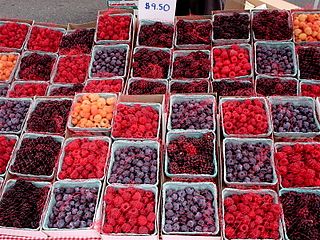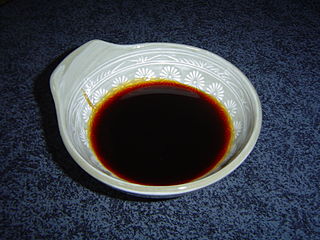Related Research Articles

Cashew is the common name of a tropical evergreen tree Anacardium occidentale, in the family Anacardiaceae. It is native to South America and is the source of the cashew nut and the cashew apple, an accessory fruit. The tree can grow as tall as 14 metres, but the dwarf cultivars, growing up to 6 m (20 ft), prove more profitable, with earlier maturity and greater yields. The cashew nut is edible and is eaten on its own as a snack, used in recipes, or processed into cashew cheese or cashew butter. The nut is often simply called a 'cashew'. Cashew can cause allergies triggered by the proteins found in the nuts.

Prunus is a genus of trees and shrubs in the flowering plant family Rosaceae that includes plums, cherries, peaches, nectarines, apricots, and almonds. The genus has a cosmopolitan distribution, being native to the North American temperate regions, the neotropics of South America, and temperate and tropical regions of Asia and Africa, There are 340 accepted species. Many members of the genus are widely cultivated for their fruit and for decorative purposes. Prunus fruit are drupes, or stone fruits. The fleshy mesocarp surrounding the endocarp is edible while the endocarp itself forms a hard, inedible shell called the pyrena. This shell encloses the seed, which is edible in some species, but poisonous in many others. Besides being eaten off the hand, most Prunus fruit are also commonly used in processing, such as jam production, canning, drying, and the seeds for roasting.

The pomegranate is a fruit-bearing deciduous shrub in the family Lythraceae, subfamily Punicoideae, that grows between 5 and 10 m tall. The pomegranate is rich in symbolic and mythological associations in many cultures.

Butylated hydroxytoluene (BHT), also known as dibutylhydroxytoluene, is a lipophilic organic compound, chemically a derivative of phenol, that is useful for its antioxidant properties. BHT is widely used to prevent free radical-mediated oxidation in fluids and other materials, and the regulations overseen by the U.S. F.D.A.—which considers BHT to be "generally recognized as safe"—allow small amounts to be added to foods. Despite this, and the earlier determination by the National Cancer Institute that BHT was noncarcinogenic in an animal model, societal concerns over its broad use have been expressed. BHT has also been postulated as an antiviral drug, but as of December 2022, use of BHT as a drug is not supported by the scientific literature and it has not been approved by any drug regulatory agency for use as an antiviral.

The University of Newcastle is a public university in Newcastle, New South Wales, Australia. Established in 1965, it has a primary campus in the Newcastle suburb of Callaghan. The university also operates campuses in Central Coast, Singapore, Newcastle City in the Hunter as well as Sydney.

Polyphenols are a large family of naturally occurring phenols. They are abundant in plants and structurally diverse. Polyphenols include flavonoids, tannic acid, and ellagitannin, some of which have been used historically as dyes and for tanning garments.

Phytochemicals are chemical compounds produced by plants, generally to help them resist fungi, bacteria and plant virus infections, and also consumption by insects and other animals. The name comes from Greek φυτόν (phyton) 'plant'. Some phytochemicals have been used as poisons and others as traditional medicine.

Browning is the process of food turning brown due to the chemical reactions that take place within. The process of browning is one of the chemical reactions that take place in food chemistry and represents an interesting research topic regarding health, nutrition, and food technology. Though there are many different ways food chemically changes over time, browning in particular falls into two main categories: enzymatic versus non-enzymatic browning processes.

Garcinia gummi-gutta is a tropical species of Garcinia native to South Asia and Southeast Asia. Common names include Garcinia cambogia, as well as brindle berry, and Malabar tamarind. The fruit looks like a small pumpkin and is green to pale yellow in color.
The University of Newcastle Students' Association (UNSA) is the student organisation at the University of Newcastle, NSW, Australia (UON). The organisation provides a range of student services and supports campus life activities and events. UNSA facilitates the UON's elected Student Representative Council (SRC) which is the peak representative body for all students at the University.

A polyphenol antioxidant is a hypothetized type of antioxidant, in which each instance would contain a polyphenolic substructure; such instances which have been studied in vitro. Numbering over 4,000 distinct chemical structures, such polyphenols may have antioxidant activity {{{1}}} in vitro (although they are unlikely to be antioxidants in vivo). Hypothetically, they may affect cell-to-cell signaling, receptor sensitivity, inflammatory enzyme activity or gene regulation, although high-quality clinical research has not confirmed any of these possible effects in humans as of 2020.

Olea europaea subsp. cuspidata is a subspecies of the well-known olive tree, which until recently was considered a separate species and is still mentioned as such in many sources. Native to northeast of Africa and the drier parts of subtropical Asia, it has various common names, including wild olive, African olive, brown olive and Indian olive.

Date honey, date syrup, date molasses, Debes, or rub is a thick dark brown, very sweet fruit syrup extracted from dates. It is widely used in Middle Eastern cuisine and Maghrebi cuisine.

Olive leaf is the leaf of the olive tree. Although olive oil is well known for its flavor and possible health benefits, the leaf and its extracts remain under preliminary research with unknown effects on human health.

Protocatechuic acid (PCA) is a dihydroxybenzoic acid, a type of phenolic acid. It is a major metabolite of antioxidant polyphenols found in green tea. It has mixed effects on normal and cancer cells in in vitro and in vivo studies.

Anthocyanins, also called anthocyans, are water-soluble vacuolar pigments that, depending on their pH, may appear red, purple, blue, or black. In 1835, the German pharmacist Ludwig Clamor Marquart gave the name Anthokyan to a chemical compound that gives flowers a blue color for the first time in his treatise "Die Farben der Blüthen". Food plants rich in anthocyanins include the blueberry, raspberry, black rice, and black soybean, among many others that are red, blue, purple, or black. Some of the colors of autumn leaves are derived from anthocyanins.

Pittosporum angustifolium is a shrub or small tree growing throughout inland Australia. Common names include weeping pittosporum, butterbush, cattle bush, native apricot, apricot tree, gumbi gumbi, cumby cumby, meemeei, poison berry bush, and berrigan.

Patricia Margaret Selkirk, is an Australian plant biologist and ecologist. Her career has focused on Antarctic and subantarctic terrestrial ecosystems and she is recognized as being a pioneering female Australian Antarctic scientist.

Edward Kent Woo is an Australian secondary school teacher and writer best known for his online mathematics lessons published on YouTube. In 2018, Woo was awarded the Australia's Local Hero Award.

Plinia peruviana, commonly known as jabuticaba cabinho in Brazil, is a species of plant in the family Myrtaceae. It is endemic to central, South America.
References
- ↑ "Scientist claims new apple product may offer new level of protection against cancers". Daily Telegraph.
- ↑ Beaumont, Anita (28 September 2016). "Super find for health | photos, video". Newcastle Herald. Retrieved 24 February 2022.
- ↑ "New antioxidant extraction method developed by researcher". ABC News. 28 September 2016. Retrieved 22 February 2022.
- ↑ "University of Newcastle spins off antioxidant, without IP fights". Australian Financial Review. 4 October 2016. Retrieved 22 February 2022.
- ↑ "Aussie apples secret to major health product". Good Fruit & Vegetables. 7 November 2019. Retrieved 23 February 2022.
- ↑ "Disease fighting superfood". The University of Newcastle, Australia. 28 September 2016. Retrieved 24 February 2022.
- ↑ Candrawinata, Vincent I.; Golding, John B.; Roach, Paul D.; Stathopoulos, Costas E. (3 April 2015). "Optimisation of the phenolic content and antioxidant activity of apple pomace aqueous extracts". CyTA - Journal of Food. 13 (2): 293–299. doi: 10.1080/19476337.2014.971344 . ISSN 1947-6337.
- ↑ "UON researchers shine in a glittering field of finalists". The University of Newcastle, Australia. 7 September 2016. Retrieved 23 February 2022.
- ↑ "2016 Alumni Awards". The University of Newcastle, Australia. 30 April 2018. Retrieved 23 February 2022.
- ↑ "This Annual Report summarises the University of Newcastle's (UON's) achievements in 2016".
- ↑ Rolfe, Brooke (31 August 2021). "'Happy accident' leads to $10m Woolies deal". news.com.au. Retrieved 22 February 2022.
- ↑ Carey, Alexis (23 April 2020). "30yo's 'surreal' $5m Woolies deal". news.com.au. Retrieved 22 February 2022.